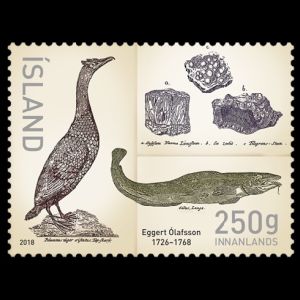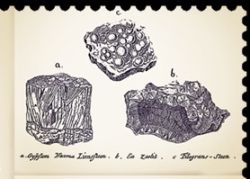the place where Paleontology and Paleoanthropology meets Philately
Iceland
Contributors to Paleontology science, fossils on stamps of Iceland
| << previous country | back to index | next country >> |
Contents:
- Country overview
- Philately of Iceland
- Some stamps of Iceland to consider
- References
- Acknowledgements
Iceland is a Nordic island country in the North Atlantic, with a population of about 350,000 and an area of 103,000 km2, making it the most sparsely populated country in Europe. The capital and largest city is Reykjavík. Reykjavík and the surrounding areas in the southwest of the country are home to over two-thirds of the population. [R1]
Geologically speaking, Iceland is a very young country and therefore there are fewer fossils found here than in many other countries No skeletons of giant land animals have been found in Iceland.
These fossils are mainly plants: impressions of leaves, carbonised plant remains, pollen grains, compressed logs, and lignite coal. They have mainly been found in the northwest part of Iceland.
The oldest fossils in Iceland are around 15 million years old. They come from the epoch in the Earth's history known as the Miocene, which began almost 24 million years ago and lasted until the start of the Pliocene around 5.3 million years ago, the final epoch of the Paleogene period.
Icelandic nature conservation law prohibits the removal of fossils from the location at which they were found, except with the express permission of the Ministry for the Environment. [R3]
On 1 January 1873, Iceland issued its first postage stamps. The design was the same as for the Danish numeral issue of the time (numeral of value surmounted by a crown all inside an oval), denominated with values ranging from 2 to 16 skilling, and inscribed ÍSLAND. All are scarce or rare, and used copies are especially hard to find.
On May 2020, Postphil, philatelic division of Iceland Post’s philatelic division, announced that Iceland
stop to produce postage stamps since 2021.
The last issue of Icelandic stamps were issued on 29th October 2020.
Iceland Post’s Customer Experience Manager Brynjar Smari Runarsson said that new printings of already-issued stamps are possible in the future.
“We have plenty of stamps in stock for customers and will continue to use them,” Runarsson said.
“If we foresee a shortage we will probably reprint older stamps in order to have sufficient stamps for senders.”
[R2]
Some stamps of Iceland to consider
| 24.04.2018 "Eggert Olafsson 250th Anniversary" [A1] | ||
 |
|
|
Notes:
[A1] On April 24th post of Iceland issued a stamp "Eggert Olafsson 250th Anniversary".
Eggert Ólafsson (1726-1768) was a poet, a writer and a naturalist from the Svefneyjar islands in the northwest of Iceland. He was one of the first advocates of the Enlightenment in Iceland.
Eggert is best known for his book on Iceland which he co-wrote with Bjarni Pálsson, one of his schoolmates in Copenhagen.
This great two-volume work "Reise igiennem Island" (Travels in Iceland), was issued with support of Danish government in 1772, four years after the death of Eggert Olafsson. The book records a scientific and cultural survey he carried out in 1752-1757, providing a comprehensive description of the country and its people. He reported fossilized leaves of “birch, rowan, and willow ... and many most similar to oaks” from the Surtarbrandsgil locality in northwestern Iceland.
One illustration from the book is depicted on the top-right corner of the stamp and shows three minerals:
a- left) Gypsum, b-right) Zeolite.
The third one c-middle top is Filegrans - steen (not clear on this moment, what kind of stone it is), perhaps
with some fossils of marine shells on it.[R3]
References:
- [R1] Iceland: Wikipedia, WikiTravel, FlagCounter, The Icelandic Institute of Natural History.
-
[R2] Postal History and Philately of Iceland:
Wikipedia,
Linn's stamp news
Links to official website of the Post Authority, stamp catalog and a list of new stamps of Iceland are here - [R3] Eggert Olafsson: Wikipedia, Encyclopedia Britanica, official stamp release, Book "Reise igiennem Island" by Eggert Olafsson and Bjarni Pálsso, printed in 1772
Acknowledgement:
Dr. Peter Voice from Department of Geological and Environmental Sciences, Western Michigan University, for the draft page review and his valuable comments.
| << previous country | back to index | next country >> |

